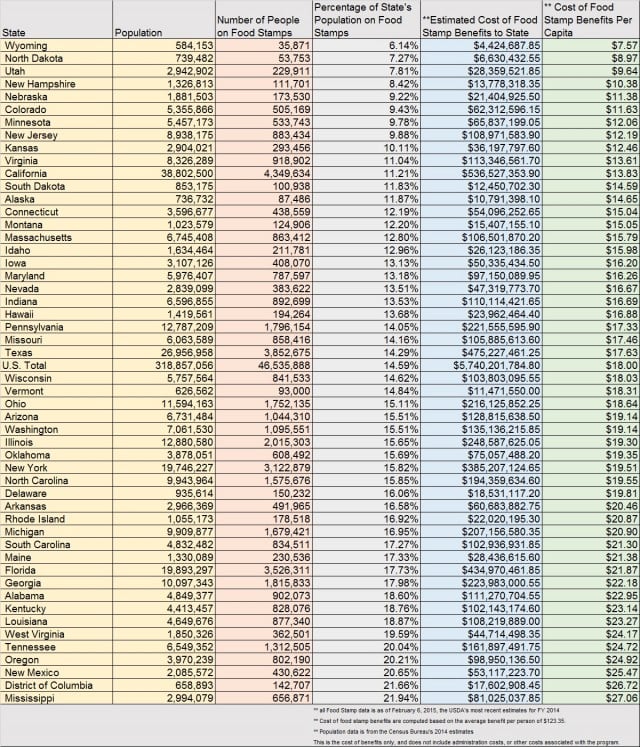With a grocery bills priced as high as $1,300 per month as of late, some American workers simply cannot afford all of their groceries on top of everything else they already have to buy. This is why the government offers food stamps.
stamps.
The USDA Food and Nutrition Service reports that as of September 2014, there were around 46.5 million individual food stamp recipients (22.7 million households) receiving an average benefit of $123.74 each (around $257 per household).
To be eligible, a household has to earn a gross income amount that’s less than 130% of the poverty level, or a net income amount (gross income minus deductions) that’s less than 100% of the poverty level for their family size.
amount that’s less than 130% of the poverty level, or a net income amount (gross income minus deductions) that’s less than 100% of the poverty level for their family size.
This means, a single person can be eligible for food stamps if his or her gross monthly income is under $1,265 ($15,180 per year), and a family of four can be eligible if they gross less than $2,584 per month ($31,008 per year). The applicant also can’t be a wealthy person who simply doesn’t have a steady income source. So, if the applicant has thousands of dollars sitting in the bank, for instance, they won’t apply as cash assets are considered as well.
if his or her gross monthly income is under $1,265 ($15,180 per year), and a family of four can be eligible if they gross less than $2,584 per month ($31,008 per year). The applicant also can’t be a wealthy person who simply doesn’t have a steady income source. So, if the applicant has thousands of dollars sitting in the bank, for instance, they won’t apply as cash assets are considered as well.
So overall, the program makes perfect sense on paper. It sounds completely reasonable: If you earn too little money, you can temporarily receive a card for your groceries for a while. Food stamps help millions of individuals and families, but the corresponding billions of dollars that the program costs make some taxpayers critical of it.
millions of individuals and families, but the corresponding billions of dollars that the program costs make some taxpayers critical of it.
A taxpayer’s view of the welfare system depends on many factors — his or her upbringing, personal experiences, and even where he or she lives. In some areas of the country, food stamp use is more common than in others.
We’ve created a list of the states that have the most food stamp recipients per capita. To determine the states on this list, we used the USDA Food Nutrition Service’s most recent state-by-state data, coupled with population data from the Census Bureau. States with the highest number of food stamp participants relative to population ranked highest. We’ve also included a state-by-state breakdown of food stamp use in all 50 states and the District of Columbia
States with the most people on food stamps
What do you think?
What do you think?
(Information is current as of February, 2015. Rankings have also changed to reflect current data.)
7. Louisiana
- Number of food stamp recipients: 877,340
- Percentage of the state’s population on food stamps
 : 18.87%
: 18.87% - Total cost of just these benefits alone (That is, how much do just the money on those EBT cards cost the state?): Around $108.22 million
- Cost of benefits alone per capita in this state: $23.27
6. West Virginia
- Number of food stamp recipients: 362,501
- Percentage of the state’s population on food stamps: 19.59%
- Total cost of just these benefits alone (That is, how much do just the money on those EBT cards cost the state?): Around $44.71 million
- Cost of benefits alone per capita in this state: $24.17 per person
5. Tennessee
- Number of food stamp recipients: Just over 1.31 million
- Percentage of the state’s population on food stamps: 20.04%
- Total cost of just these benefits alone (That is, how much do just the money on those EBT cards cost the state?): Around $161.9 million
- Cost of benefits alone per capita in this state: $24.72
4. Oregon
- Number of food stamp recipients: 802,190
- Percentage of the state’s population on food stamps: 20.21%
- Total cost of just these benefits alone (That is, how much do just the money on those EBT cards cost the state?): Around $98.96 million
- Cost of benefits alone per capita in this state: $24.92 per person
3. New Mexico
- Number of food stamp recipients: 430,622
- Percentage of the state’s population on food stamps: 20.65%
- Total cost of just these benefits alone (That is, how much do just the money on those EBT cards cost the state?): Around $53.12 million
- Cost of benefits alone per capita in this state: $25.47 per person
2. District of Columbia
- Number of food stamp recipients: 142,707
- Percentage of the state’s population on food stamps: 21.66%
- Total cost of just these benefits alone (That is, how much do just the money on those EBT cards cost the state?): Around $17.6 million
- Estimated cost of benefits alone per capita in this state: $26.72 per person
1. Mississippi
- Number of food stamp recipients: 656,871
- Percentage of the state’s population on food stamps: 21.94%
- Total cost of just these benefits alone (That is, how much do just the money on those EBT cards cost the state?): Around $81.03 million
- Estimated cost of benefits alone per capita in this state: $27.06 per person

Your Reaction?
Graphic by Erika Rawes//data from Census and USDA
No comments:
Post a Comment